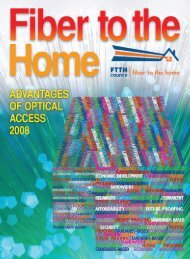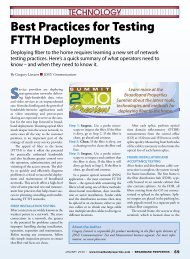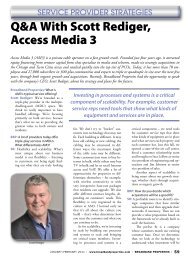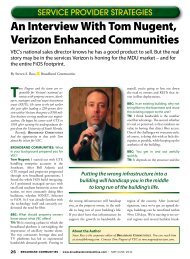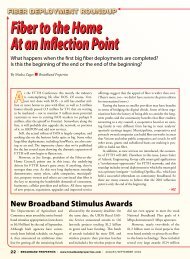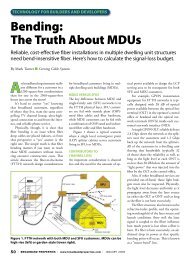2010 Buyers Guide - Broadband Properties
2010 Buyers Guide - Broadband Properties
2010 Buyers Guide - Broadband Properties
Create successful ePaper yourself
Turn your PDF publications into a flip-book with our unique Google optimized e-Paper software.
using broadband. What is more interesting<br />
is how businesses are changing the<br />
way they conduct business. <strong>Broadband</strong><br />
enables deeper engagement in e-commerce,<br />
reshaping business and industry<br />
supply chains and products. The OECD<br />
views that broadband will replicate and<br />
possibly even exceed the economic gains<br />
from the use of previous GPTs including<br />
ICT at large.<br />
Substantive economic impacts will be<br />
reflected in productivity changes – that<br />
is, improvements in labor productivity<br />
where genuine broadband services make<br />
work easier, and, more important, multifactor-productivity<br />
(MFP) gains where<br />
broadband reduces friction in many supply<br />
chains in the economy. MFP is more<br />
valuable than labor productivity because<br />
it makes the whole system work better.<br />
There is already some empirical evidence<br />
about these gains from ICT in general<br />
and genuine broadband in particular.<br />
The CIE has recently been using its<br />
detailed economywide models to evaluate<br />
the impacts of broadband and other<br />
technological changes and how differences<br />
in commercial structures may<br />
alter the outcomes. The model used is<br />
the Monash Multi-Regional Forecasting<br />
(MMRF) model, also used by key<br />
economic agencies including, most<br />
recently, the Australian Government<br />
Treasury when estimating the impact<br />
of combating greenhouse-gas emissions.<br />
These models look at the long-term impacts<br />
after all the direct shocks, changes<br />
in prices, exchange rates, employment,<br />
investment, multipliers and other flow<br />
effects are taken into account.<br />
A key input to the analysis is the<br />
extent of productivity gains. After conducting<br />
an exhaustive study over several<br />
years, the Productivity Commission<br />
recently reported evidence that ICT<br />
investment generated a multifactor productivity<br />
gain of between 0.15 to 0.2 per<br />
cent per annum over the 1990s. If the<br />
OECD is correct, genuine broadband<br />
alone could stimulate a similar gain in<br />
coming years; it would be reasonable to<br />
expect an MFP gain of around 1 percent<br />
over the medium term (say five to<br />
six years). If adoption is slower than expected,<br />
then these gains would take longer<br />
to be realized. The MMRF model<br />
A general-purpose technology, broadband<br />
changes the way businesses conduct<br />
their business. It deepens engagement in<br />
e-commerce and reshapes supply chains.<br />
has been used to see what the economywide<br />
implications would be from this<br />
productivity improvement in the medium<br />
to longer term.<br />
<strong>Broadband</strong> to Lift Australia’s<br />
Output by 1.4%<br />
The MMRF simulation results show<br />
that genuine broadband offers gains<br />
over most economic indicators. GDP<br />
would rise. An increase of around 1.4<br />
per cent is projected after about five<br />
to six years. This is equivalent to $15<br />
billion [all amounts are in Australian<br />
dollars] in terms of GDP in 2007–08.<br />
Prices would fall – by around half a percent.<br />
The Australian economy would be<br />
more competitive and export more, and<br />
investment would grow.<br />
The industry results point to a structural<br />
change in the economy. Retail and<br />
wholesale activities will be smaller than<br />
otherwise, reflecting direct sales and supply<br />
chain consolidation. Other activities<br />
grow as they offer greater value to customers<br />
(such as health, education and<br />
recreation). Residential building grows<br />
by a lot, reflecting Australia’s penchant<br />
for real estate and the family home.<br />
BIGGER COSTS ARISING FROM<br />
IMPERFECT COMPETITION AND<br />
HIGHER PRICES<br />
The second main thread of this article is<br />
about the investment cost. This is not a<br />
discussion about the cost of broadband<br />
technologies or difficulties in estimating<br />
what it might be. These possible costs<br />
November/December 2009 | www.broadbandproperties.com | BROADBAND PROPERTIES | 65



